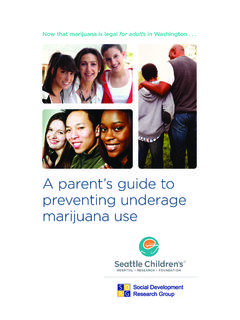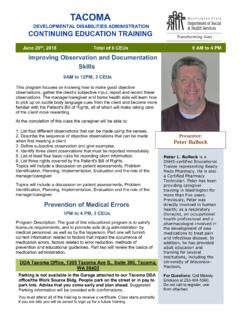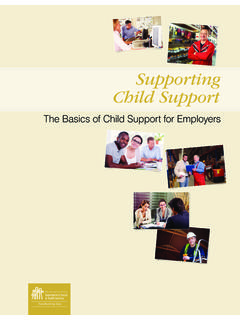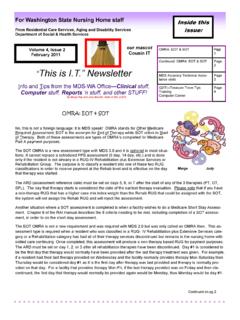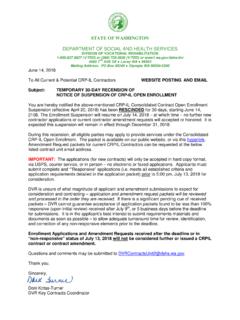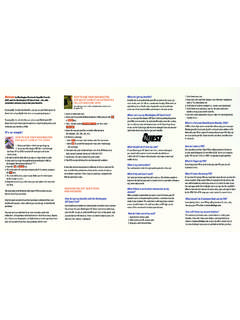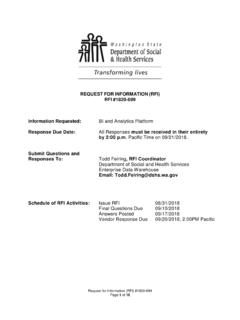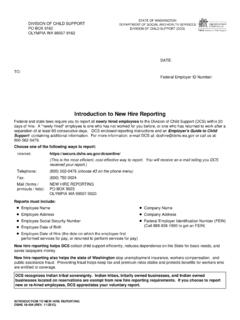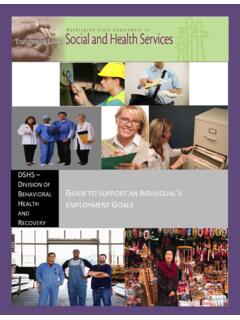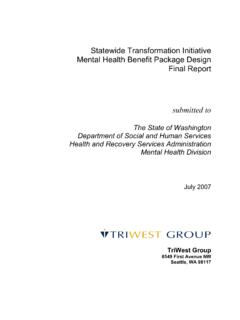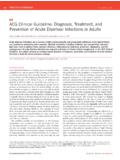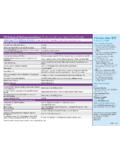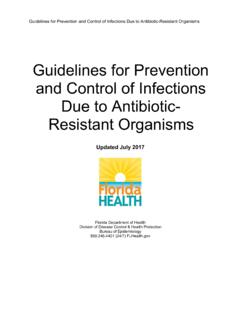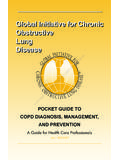Transcription of CENTERS FOR DISEASE CONTROL TB GUIDELINES SUMMARY OF CDC ...
1 1 CENTERS FOR DISEASE CONTROL TB GUIDELINES SUMMARY OF CDC GUIDELINES The CDC GUIDELINES for Preventing the Transmission of Mycobacterium Tuberculosis in Health-Care Settings, 2005, enforced by the federal Occupational Safety and Health Administration (OSHA) and our state Labor and Industries Division of Occupational Safety and Health, require chemical dependency treatment programs to: 1. Appoint a TB Infection CONTROL Program Manager. 2. Conduct an annual TB Infection CONTROL Risk Assessment of their health care setting. (Attached sample is CDC Appendix B, TB Risk Assessment Worksheet. See questions 1 4, first part of question 5, and question 9. Questions 5 though 8 may not apply to your health care setting.) 3. Write and update annually a TB Infection CONTROL Plan that describes the agency s administrative, environmental, and respiratory infection controls that are appropriate for the level of risk at their setting.
2 (See TB Model Policies located at: , Sections I - IV.) The plan requires: a. Baseline testing of all health care workers. Further testing of health care workers is done only as indicated by the provider s annual risk assessment. Agencies with low risk would not require additional testing of every employee - only those whose annual risk assessment or symptom screen indicated the need for further testing. Agencies with medium risk would continue to require annual testing, but only at worksites that have had three or more active cases of TB in the past year. b. TB screening of all patients at intake by taking their TB medical history, conduct a TB risk assessment and a TB symptom screen, but only those at risk or having symptoms of TB require a TB test. (Attached sample is Appendix I of the TB Model Policies.) The annual risk assessment determines which patients need to be tested at each treatment site.
3 CDC GUIDELINES state testing should not be done on substance abusers unless they are at high risk of TB infection due to other risk factors such as: IV drug use (between 9% recent and 26% lifetime - TARGET patients), HIV infection ( report having an infectious DISEASE at admission), Resident of a correction facility (2 % came from jail/prison), Homeless facility (8% report they came from a homeless shelter or lived on the street at admission), Close contact with someone with infectious TB, recently traveled to or emigrated from a country with a high incidence of TB, CENTERS for DISEASE CONTROL and prevention Division of Tuberculosis Elimination 2 Appendix B.
4 Tuberculosis (TB) risk assessment worksheet This model worksheet should be considered for use in performing TB risk assessments for health-care facilities and nontraditional facility-based settings. Facilities with more than one type of setting will need to apply this table to each setting. Scoring or Y = Yes X or N = No NA = Not Applicable 1. Incidence of TB What is the incidence of TB in your community (county or region served by the health-care setting), and how does it compare with the state and national average? What is the incidence of TB in your facility and specific settings and how do those rates compare? (Incidence is the number of TB cases in your community the previous year. A rate of TB cases per 100,000 persons should be obtained for comparison.)* This information can be obtained from the state or local health department.
5 Community rate_____ State rate _____ National rate _____ Facility rate _____ Department 1 rate _____ Department 2 rate _____ Department 3 rate _____ Are patients with suspected or confirmed TB DISEASE encountered in your setting (inpatient and outpatient)? Yes No If yes, how many patients with suspected and confirmed TB DISEASE are treated in your health-care setting in 1 year (inpatient and outpatient)? Review laboratory data, infection- CONTROL records, and databases containing discharge diagnoses. Year No. patients Suspected Confirmed 1 year ago _____ _____ 2 years ago _____ _____ 5 years ago _____ _____ If no, does your health-care setting have a plan for the triage of patients with suspected or confirmed TB DISEASE ? Yes No Currently, does your health-care setting have a cluster of persons with confirmed TB DISEASE that might be a result of ongoing transmission of Mycobacterium tuberculosis within your setting (inpatient and outpatient)?
6 Yes No 09/27/2006 CENTERS for DISEASE CONTROL and prevention Division of Tuberculosis Elimination 3 2. Risk Classification Inpatient settings How many inpatient beds are in your inpatient setting? How many patients with TB DISEASE are encountered in the inpatient setting in 1 year? Review laboratory data, infection- CONTROL records, and databases containing discharge diagnoses. Previous year _____ 5 years ago _____ Depending on the number of beds and TB patients encountered in 1 year, what is the risk classification for your inpatient setting?
7 (See Appendix C.) Low risk Medium risk Potential ongoing transmission Does your health-care setting have a plan for the triage of patients with suspected or confirmed TB DISEASE ? Yes No Outpatient settings How many TB patients are evaluated at your outpatient setting in 1 year? Review laboratory data, infection- CONTROL records, and databases containing discharge diagnoses. Previous year _____ 5 years ago _____ Is your health-care setting a TB clinic? (If yes, a classification of at least medium risk is recommended.) Yes No Does evidence exist that a high incidence of TB DISEASE has been observed in the community that the health-care setting serves? Yes No Does evidence exist of person-to-person transmission of M. tuberculosis in the health-care setting? (Use information from case reports.)
8 Determine if any tuberculin skin test [TST] or blood assay for M. tuberculosis [BAMT] conversions have occurred among health-care workers [HCWs]). Yes No Does evidence exist that ongoing or unresolved health-care associated transmission has occurred in the health-care setting (based on case reports)? Yes No Is there a high incidence of immunocompromised patients or HCWs in the health-care setting? Yes No Have patients with drug-resistant TB DISEASE been encountered in your health-care setting within the previous 5 years? Yes No Year _____ 09/27/2006 CENTERS for DISEASE CONTROL and prevention Division of Tuberculosis Elimination 4 When was the first time a risk classification was done for your health-care setting?
9 _____ Considering the items above, would your health-care setting need a higher risk classification? Yes No Depending on the number of TB patients evaluated in 1 year, what is the risk classification for your outpatient setting? (See Appendix C) Low risk Medium risk Potential ongoing transmission Does your health-care setting have a plan for the triage of patients with suspected or confirmed TB DISEASE ? Yes No Nontraditional facility-based settings How many TB patients are encountered at your setting in 1 year? Previous year _____ 5 years ago _____ Does evidence exist that a high incidence of TB DISEASE has been observed in the community that the setting serves? Yes No Does evidence exist of person-to-person transmission of M. tuberculosis in the setting? Yes No Have any recent TST or BAMT conversions occurred among staff or clients?
10 Yes No Is there a high incidence of immunocompromised patients or HCWs in the setting? Yes No Have patients with drug-resistant TB DISEASE been encountered in your health-care setting within the previous 5 years? Yes No Year _____ When was the first time a risk classification was done for your setting? Considering the items above, would your setting require a higher risk classification? Yes No Does your setting have a plan for the triage of patients with suspected or confirmed TB DISEASE ? Yes No Depending on the number of patients with TB DISEASE who are encountered in a nontraditional setting in 1 year, what is the risk classification for your setting? (See Appendix C) Low risk Medium risk Potential ongoing transmission 09/27/2006 CENTERS for DISEASE CONTROL and prevention Division of Tuberculosis Elimination 5 3.
